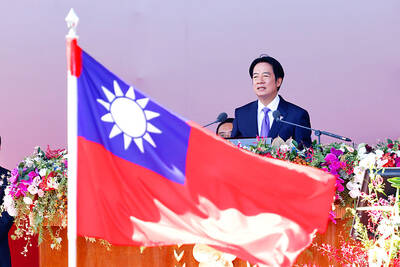The US should deepen and broaden its military relations with Taiwan, a conference on military growth in the Asia-Pacific region has been told.
Project 2049 Institute executive director Mark Stokes said that Taipei could play a bigger role in US defense policy and make a significant contribution to the Pentagon’s new Air Sea Battle strategy. As the US Department of Defense and the administration of US President Barack Obama moves to rebalance its forces in the Asia-Pacific region they should rebalance relations with Taiwan, Stokes said.
Addressing an American Enterprise Institute conference on “Arms racing in Asia? Who’s winning, who’s losing,” Stokes said Taiwan could “assist and contribute” to solving US challenges.
The Washington conference was aimed at assessing the implications of major military modernization efforts in Asia.
Stokes said that despite conflicts in the South China Sea, Taiwan remained the primary “planning focus” of China’s People’s Liberation Army (PLA).
“It is still at the center of the planning scenario that the PLA uses in order to shape their future force structure,” Stokes said.
As a result, he added, Taiwan should be central to the planning of future US force structure.
“It is not that the South China Sea is not important, but rocks and water, and even navigation pale in comparison to the lives of 23 million people,” he said.
Of all the societies in the Asia-Pacific region, none understands China like Taiwan, he said.
“If one wants to understand the thinking that goes on in Beijing, one needs to look no further than Taiwan,” Stokes said.
The US Department of Defense should consider sending students to Taiwan National Defense University, he said.
Stokes argued that Taiwan was one of the most innovative societies in the world, and that it is ideally placed to help the US to be more innovative and to reduce the cost of weapons systems.
Taiwan is also ideal as a “platform for situational awareness,” not just for military purposes, but also for disaster warning, climate change and for tracking objects in space, he said.
A lot of attention has been given to Chinese cyberespionage, and Taiwan remains Beijing’s first and its most intense target of cyberespionage, he said. Over the years Taiwan’s security services have accumulated great experience in dealing with the problem and they could provide considerable help to the US, he added.
Stokes also said that Taiwan faces “the most stressing military challenge in the world.”
“If Taiwan, working together with the US, can address and meet this most significant military challenge, then the odds are the US can meet such challenges all over the world,” he said.
Stokes said that Taiwan is a “core interest” of the US and is “fundamental to US interests in the region.”
“Deepening and broadening military relations with Taiwan need not complicate our relationship with China,” he said.
However, Beijing should understand that as long as military coercion remained a central part of its broader strategy to resolve political differences with Taiwan, it was in the best interests of Washington to intensify its military relations with Taipei, he said.

The combined effect of the monsoon, the outer rim of Typhoon Fengshen and a low-pressure system is expected to bring significant rainfall this week to various parts of the nation, the Central Weather Administration (CWA) said. The heaviest rain is expected to occur today and tomorrow, with torrential rain expected in Keelung’s north coast, Yilan and the mountainous regions of Taipei and New Taipei City, the CWA said. Rivers could rise rapidly, and residents should stay away from riverbanks and avoid going to the mountains or engaging in water activities, it said. Scattered showers are expected today in central and

People can preregister to receive their NT$10,000 (US$325) cash distributed from the central government on Nov. 5 after President William Lai (賴清德) yesterday signed the Special Budget for Strengthening Economic, Social and National Security Resilience, the Executive Yuan told a news conference last night. The special budget, passed by the Legislative Yuan on Friday last week with a cash handout budget of NT$236 billion, was officially submitted to the Executive Yuan and the Presidential Office yesterday afternoon. People can register through the official Web site at https://10000.gov.tw to have the funds deposited into their bank accounts, withdraw the funds at automated teller

COOPERATION: Taiwan is aligning closely with US strategic objectives on various matters, including China’s rare earths restrictions, the Ministry of Foreign Affairs said Taiwan could deal with China’s tightened export controls on rare earth metals by turning to “urban mining,” a researcher said yesterday. Rare earth metals, which are used in semiconductors and other electronic components, could be recovered from industrial or electronic waste to reduce reliance on imports, National Cheng Kung University Department of Resources Engineering professor Lee Cheng-han (李政翰) said. Despite their name, rare earth elements are not actually rare — their abundance in the Earth’s crust is relatively high, but they are dispersed, making extraction and refining energy-intensive and environmentally damaging, he said, adding that many countries have opted to

PEACE AND STABILITY: Maintaining the cross-strait ‘status quo’ has long been the government’s position, the Ministry of Foreign Affairs said Taiwan is committed to maintaining the cross-strait “status quo” and seeks no escalation of tensions, the Ministry of Foreign Affairs (MOFA) said yesterday, rebutting a Time magazine opinion piece that described President William Lai (賴清德) as a “reckless leader.” The article, titled “The US Must Beware of Taiwan’s Reckless Leader,” was written by Lyle Goldstein, director of the Asia Program at the Washington-based Defense Priorities think tank. Goldstein wrote that Taiwan is “the world’s most dangerous flashpoint” amid ongoing conflicts in the Middle East and Russia’s invasion of Ukraine. He said that the situation in the Taiwan Strait has become less stable